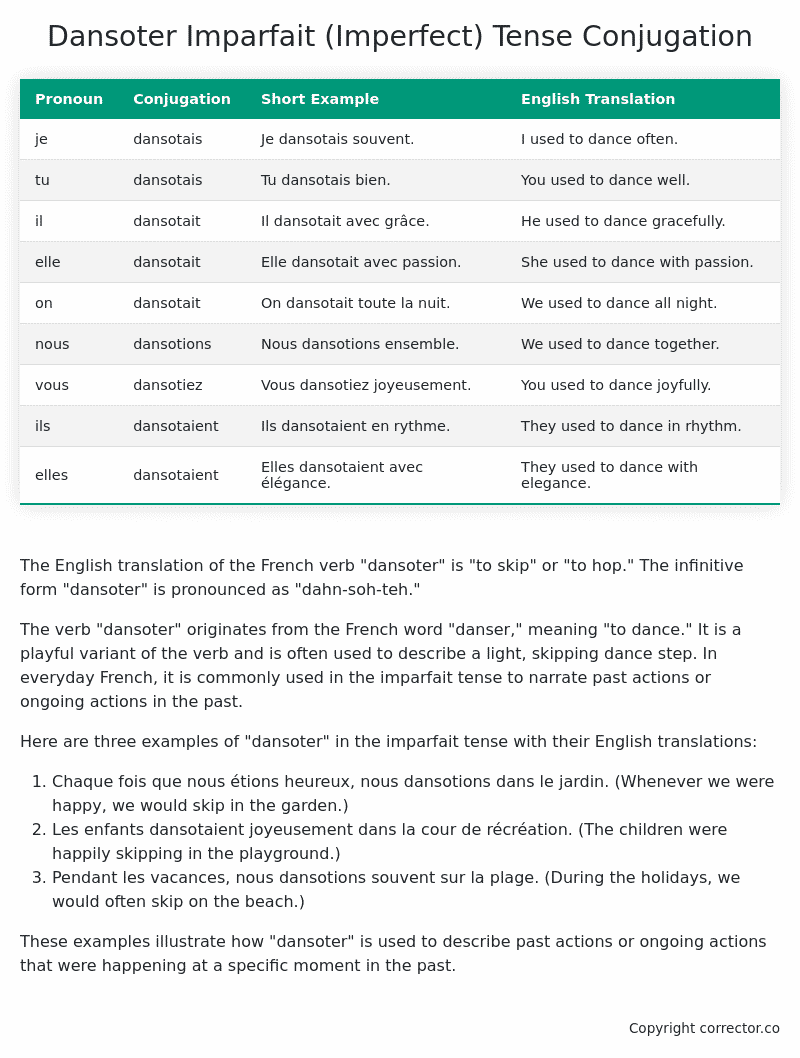Imparfait (Imperfect) Tense Conjugation of the French Verb dansoter
Introduction to the verb dansoter
The English translation of the French verb “dansoter” is “to skip” or “to hop.” The infinitive form “dansoter” is pronounced as “dahn-soh-teh.”
The verb “dansoter” originates from the French word “danser,” meaning “to dance.” It is a playful variant of the verb and is often used to describe a light, skipping dance step. In everyday French, it is commonly used in the imparfait tense to narrate past actions or ongoing actions in the past.
Here are three examples of “dansoter” in the imparfait tense with their English translations:
- Chaque fois que nous étions heureux, nous dansotions dans le jardin.
(Whenever we were happy, we would skip in the garden.) - Les enfants dansotaient joyeusement dans la cour de récréation.
(The children were happily skipping in the playground.) - Pendant les vacances, nous dansotions souvent sur la plage.
(During the holidays, we would often skip on the beach.)
These examples illustrate how “dansoter” is used to describe past actions or ongoing actions that were happening at a specific moment in the past.
Table of the Imparfait (Imperfect) Tense Conjugation of dansoter
| Pronoun | Conjugation | Short Example | English Translation |
|---|---|---|---|
| je | dansotais | Je dansotais souvent. | I used to dance often. |
| tu | dansotais | Tu dansotais bien. | You used to dance well. |
| il | dansotait | Il dansotait avec grâce. | He used to dance gracefully. |
| elle | dansotait | Elle dansotait avec passion. | She used to dance with passion. |
| on | dansotait | On dansotait toute la nuit. | We used to dance all night. |
| nous | dansotions | Nous dansotions ensemble. | We used to dance together. |
| vous | dansotiez | Vous dansotiez joyeusement. | You used to dance joyfully. |
| ils | dansotaient | Ils dansotaient en rythme. | They used to dance in rhythm. |
| elles | dansotaient | Elles dansotaient avec élégance. | They used to dance with elegance. |
Other Conjugations for Dansoter.
Le Present (Present Tense) Conjugation of the French Verb dansoter
Imparfait (Imperfect) Tense Conjugation of the French Verb dansoter (You’re reading it right now!)
Passé Simple (Simple Past) Tense Conjugation of the French Verb dansoter
Passé Composé (Present Perfect) Tense Conjugation of the French Verb dansoter
Futur Simple (Simple Future) Tense Conjugation of the French Verb dansoter
Futur Proche (Near Future) Tense Conjugation of the French Verb dansoter
Plus-que-parfait (Pluperfect) Tense Conjugation of the French Verb dansoter
Passé Antérieur (Past Anterior) Tense Conjugation of the French Verb dansoter
Futur Antérieur (Future Anterior) Tense Conjugation of the French Verb dansoter
Subjonctif Présent (Subjunctive Present) Tense Conjugation of the French Verb dansoter
Subjonctif Passé (Subjunctive Past) Tense Conjugation of the French Verb dansoter
Subjonctif Imparfait (Subjunctive Imperfect) Tense Conjugation of the French Verb dansoter
Subjonctif Plus-que-parfait (Subjunctive Pluperfect) Tense Conjugation of the French Verb dansoter
Conditionnel Présent (Conditional Present) Tense Conjugation of the French Verb dansoter
Conditionnel Passé (Conditional Past) Tense Conjugation of the French Verb dansoter
Conditionnel Passé II (Conditional Past II) Tense Conjugation of the French Verb dansoter
L’impératif Présent (Imperative Present) Tense Conjugation of the French Verb dansoter
L’impératif Passé (Imperative Past) Tense Conjugation of the French Verb dansoter
L’infinitif Présent (Infinitive Present) Tense Conjugation of the French Verb dansoter
L’infinitif Passé (Infinitive Past) Tense Conjugation of the French Verb dansoter
Le Participe Présent (Present Participle) Tense Conjugation of the French Verb dansoter
Le Participe Passé (Past Participle) Tense Conjugation of the French Verb dansoter
Struggling with French verbs or the language in general? Why not use our free French Grammar Checker – no registration required!
Get a FREE Download Study Sheet of this Conjugation 🔥
Simply right click the image below, click “save image” and get your free reference for the dansoter imparfait tense conjugation!

Dansoter – About the French Imparfait Tense
NOTE: To take a deep dive into all the French tenses then see our article on Mastering French Tense Conjugation.
Formation of the Imparfait Tense
For regular -er verbs:
For regular -ir verbs
For regular -re verbs
Common Everyday Usage Patterns
Description of Past Habits
Background Information
Mental and Emotional States
It’s employed to express emotions, thoughts, or physical sensations in the past. For example: “J’étais content quand il est arrivé.” (I was happy when he arrived.)
Ongoing Actions
Points to Note About the Imparfait Tense
Passé Composé vs. Imparfait
Conditional
Si Clauses
Narration
I hope you enjoyed this article on the verb dansoter. Still in a learning mood? Check out another TOTALLY random French verb imparfait conjugation!


